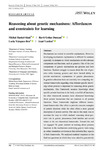Mostrar o rexistro simple do ítem
Reasoning about genetic mechanisms: Affordances and constraints for learning
| dc.contributor.author | Haskel-Ittah, Michal | |
| dc.contributor.author | Duncan, Ravit | |
| dc.contributor.author | Vázquez-Ben, Lucía | |
| dc.contributor.author | Yarden, Anat | |
| dc.date.accessioned | 2024-02-05T12:11:21Z | |
| dc.date.issued | 2019-09-09 | |
| dc.identifier.citation | Haskel-Ittah M, Duncan RG, Vázquez-Ben L, Yarden A. Reasoning about genetic mechanisms: Affordances and constraints for learning. J Res Sci Teach. 2020; 57: 342–367. https://doi.org/10.1002/tea.21595 | es_ES |
| dc.identifier.issn | 0022-4308 | |
| dc.identifier.uri | http://hdl.handle.net/2183/35393 | |
| dc.description.abstract | [Abstract] Mechanisms are central in scientific explanations. However, developing mechanistic explanations is difficult for students especially in domains in which mechanisms involve abstract components and functions, such as genetics. One of the core components of genetic mechanisms are proteins and their functions. Students struggle to reason about the role of proteins while learning genetics and show limited ability to provide mechanistic explanations of genetic phenomena. In genetics education there are currently two competing theoretical frameworks regarding what domain-specific knowledge about proteins is important for reasoning about genetic mechanisms. One framework assumes knowledge about specific protein functions in the body, a tool kit of functions; the other framework assumes more abstracted knowledge about protein interactions that are common to all protein functions. These frameworks implicate different instructional frameworks: One offers to provide concrete examples of protein functions while the other offers a more general description of protein activity. Our aim in this study was to ascertain the ways in which students' reasoning about proteins' role in genetic phenomena (both familiar and novel) relates to the two theoretical frameworks. Toward this end we engaged 7th grade students in learning about proteins functions in the mechanisms underlying genetic traits using an online simulation environment that embodied key aspects of both frameworks. We analyzed students' responses to the final test questions in which they were asked to generatively reason about the underlying mechanisms of two novel genetic traits. Our findings suggest that students use proteins in their explanations mainly when they can explain the protein function and that knowledge about a few specific functions is insufficient to support conceptualization of new functions. Moreover, knowledge of general protein activities common to most functions is also insufficient. We suggest a new combined approach to supporting students' understanding of proteins' role in genetic mechanisms. | es_ES |
| dc.description.sponsorship | Funding information: INDITEX-UDC (2017); Ministerio de Economía y Competitividad, Grant/Award Number: EDU2015-6643-C2-2-P; Combined Weizmann - Abroad Postdoctoral Grant for Advancing Women in Science; Xunta de Galicia (Spain), Grant/Award Number: ED48A-2016/2 | es_ES |
| dc.description.sponsorship | Ministerio de Economía y Competitividad; EDU2015-6643-C2-2-P | es_ES |
| dc.description.sponsorship | Xunta de Galicia; ED48A-2016/2 | es_ES |
| dc.language.iso | eng | es_ES |
| dc.publisher | Wiley | es_ES |
| dc.relation.uri | https://doi.org/10.1002/tea.21595 | es_ES |
| dc.rights | © 2019 Wiley Periodicals, Inc. | es_ES |
| dc.subject | Domain-specific-knowledge | es_ES |
| dc.subject | Mechanistic reasoning | es_ES |
| dc.subject | Molecular genetics | es_ES |
| dc.title | Reasoning about genetic mechanisms: Affordances and constraints for learning | es_ES |
| dc.type | info:eu-repo/semantics/article | es_ES |
| dc.rights.access | info:eu-repo/semantics/embargoedAccess | es_ES |
| dc.date.embargoEndDate | 9999-99-99 | es_ES |
| dc.date.embargoLift | 10007-06-07 | |
| UDC.journalTitle | Journal of Research in Science Teaching | es_ES |
| UDC.volume | 57 | es_ES |
| UDC.issue | 3 | es_ES |
| UDC.startPage | 342 | es_ES |
| UDC.endPage | 367 | es_ES |
Ficheiros no ítem
Este ítem aparece na(s) seguinte(s) colección(s)
-
GI-IECM - Artigos [43]






